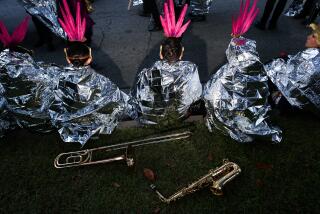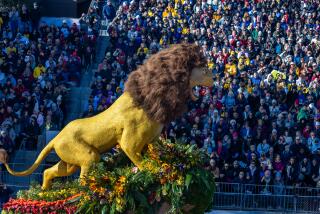As Rose Parade prepares to roll, Cal Poly Pomona hasn’t yet begun construction of $3.7-million Rose Float Lab
Cal Poly Pomona has taken pride in its Rose Float program since 1949, when one student, Don Miller, helped bootstrap the university’s first float in just 90 days with a couple hundred dollars.
Despite the praise the university has received for its Rose Parade float entries in the years since then, students continue working in an open-air warehouse built decades ago — less than ideal conditions for the painstaking work, officials say.
For the record:
2:25 p.m. Dec. 27, 2018A previous version of this article stated that Cal Poly Pomona hasn’t had a football team since the 1960s. In fact, the football team’s last year was 1982.
In October 2017, the university announced it would build a $3.7-million Rose Float Lab and Design Complex for its Rose Float program with private funding.
“[Students will] be more inspired and have the room and design workspace to come up with even more innovative ideas than in the past,” Cynthia Peters, a university spokeswoman, told The Times after the announcement.
But, a year later and less than a week before the 130th Rose Parade kicks off New Year’s Day, the project has yet to break ground.
Cal Poly Pomona and San Luis Obispo are the only universities that build Rose Parade floats themselves, said Janetta McDowell, director of the university’s Rose Float program. The students commit to 13 months of work on the project — from designing to engineering and then marketing. The work offers an opportunity for students to live by the school motto, “learn by doing,” McDowell said.
With a 70-year streak, Cal Poly universities are some of the longest running Rose Parade participants. The Sierra Madre Rose Float Assn. and the City of Alhambra have participated for 88 and 91 years respectively.
Cal Poly Pomona hasn’t had a football team since 1982, so its Rose Float program is what rallies the campus community together, McDowell said. The school’s farm store and the College of Agriculture help supply natural materials, and students grow flowers in the campus flower field.
The students even built the facility they work out of now, more than 30 years ago. It’s a “well loved” outdoor structure that’s only partially covered with sheet metal, said Krista Spangler, director of development in the university’s student affairs office.
There’s an indoor storage space and machine shop, but students work mostly outside on a concrete foundation, said Chris Maciosek, a 22-year-old mechanical engineering student. “When it rains, some sections of our lab can get under 2 inches of water,” said Maciosek, who is construction chairman for the Pomona team. “It’s also fairly small. We have a lot of equipment and raw material that we’re constantly reorganizing to make sure we’re not stepping over stuff.”
Some storage spaces that hold equipment and decorations, as well as the students’ portable kitchen and bathrooms, are spread out a distance away from the building area, chewing up time and opportunities for collaboration. ”Sometimes it takes quite a while to find someone because you never know where they’ll be in this whole place,” he said.
A new working space has become a necessity, primarily because exposure to the elements can be unsafe for students and because they are unable to lock up their equipment, McDowell said.
“If the students are welding and it starts raining, that’s a safety hazard,” she said.
Still they’ve managed another substantial creation for Tuesday’s parade — a 48-foot-long, 23-foot-high float called “Far Out Frequencies” with little green aliens playing music with astronauts, promoting a message of goodwill.
Students will do it all again next year in the same facility, since the new building won’t be open until at least January 2020.
Officials initially said the project would break ground in mid-2018. A ceremonial groundbreaking was held in November, but officials said construction wouldn’t start until February or March.
Spangler said the months’ delay on the project was due to small tweaks made to the facility’s design, such as placement of electrical outlets, which had to be reviewed by different agencies before approval. The design is now ready to go to bid for a contractor. The 1/3-acre space will include a hydraulic shop, an electronic shop, 5,000 square feet of storage space and a 7,500-square-foot courtyard for outdoor working, as well as an outdoor picnic and gathering area. It’s also placed near the school’s entrance, giving the program increased visibility.
In the last year, the university surpassed its funding goal of $3.7 million, which is the estimated cost to build just the complex’s main indoor structure, Spangler said. The school now has $4.2 million to work with, but is continuing to accept donations in hopes it can expand the facility.
“We won’t know the final cost until we finish the bid. The more money we have, the more we can expand,” Spangler said.
Even without the luxury, Cal Poly has managed to be one of the Rose Parade’s most innovative participants. The university was the first to introduce hydraulics for animation in 1968 and computer-controlled animation in 1978. Over the years, it has earned 58 awards.
At the request of alumnus Wilford Lindley and his wife Vivien Lindley, who donated $1 million to fund the project, the Lab and Design Complex’s primary building will be named after alumni Don Miller, who kicked off the campus’ Rose Float program, and Ron Simons, who helped continue the tradition.
alejandra.reyesvelarde@latimes.com
Twitter: @r_valejandra
More to Read
Start your day right
Sign up for Essential California for news, features and recommendations from the L.A. Times and beyond in your inbox six days a week.
You may occasionally receive promotional content from the Los Angeles Times.







